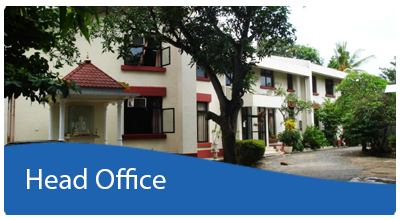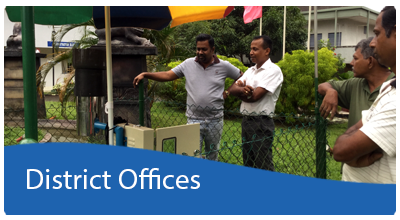With the disastrous landslides that occurred in mid 1980’s, the Government of Sri Lanka took the initiatives of studying the landslide phenomena in the country. On June 16th 1986, the Cabinet of Ministers of the Sri Lankan Government decided to launch the Landslide Hazard Zonation Mapping Project (LHMP) to study and identify the distribution of landslide potential in the central highlands. Phase I of LHMP was carried out between 1990 and 1995. The National Building Research Organisation (NBRO) was selected as the executing agency of LHMP, mainly due to availability of multidisciplinary expertise at NBRO.
During the five year period that Phase I of LHMP was in operation, 863 landslides in NuwaraEliya district and 213 landslides in Badulla district were studied in detail to identify the major causative factors of landslides and their relative contribution. The result of those field studies along with both national and international expertise in the fields of Geology, Geography, Geotechnical Engineering, Hydrology and Sociology were heavily utilized, and a probabilistic methodology for landslide hazard zonation was developed at NBRO. The major tangible output of this project was the 30 landslide hazard zonation maps prepared at 1:10000 scale covering 1200 sq. km of land area within above two districts. Development of general guidelines for construction and development of landslide prone areas and building the capacity of NBRO to continue the subsequent phases were the other major outcomes of LHMP-Phase I.
With the successful completion of LHMP-Phase I, in 1995, the GOSL decided to extend the project into the other landslide prone areas of the country also. As a result, highly landslide potential areas in Ratnapura, Kegalle Kandy and Matale administrative districts were mapped under the LHMP – Phase II. NBRO was requested to extend the landslide hazard zonation mapping programme to the southern districts of Matara, Galle and Hambantota also. Presently, NBRO is successfully in the process of establishing sustainable, long-term and short-term mechanisms for landslide disaster management in Sri Lanka.
1:50000 scale maps
The 1:50000 scale maps are developed based on the relative contribution of geological, topographical, land use and land management attributes. The 1:50000 maps cover the entire and partially land areas of twelve mountainous district of Sri Lanka namely, Matale, Kandy, Badulla, NuwaraEliya, Kegalle, Ratnapura,Kalutara, Moneragala, Galle, Matara, HambantotaandKurunegala. These 1:50000 scale maps could be used in evaluating the distribution of landslide potential at national level and the maps could be utilized in disaster management activities due to landslides.
|
LEGEND |
||
|
RANGE |
LANDSLIDE HAZARD POTENTIAL |
ZONAL SIGNIFICANCE |
|
4 |
Landslides are most likely to occur |
Danger and potential threat to life and property exists. No new construction should therefore be permitted. Essential additions in the existing structures may be allowed only after thorough site investigation and adequate precautions to be certified by specialists.Early warning systems should be established if symptoms of landslides are clear and risk levels are high |
|
3 |
Landslides are to be expected |
Moderate level of landslide danger exists. New construction should be discouraged, and improved land use planning practices should be introduced to halt and reverse the process of slope degradation. All essential construction and remediation, and new projects are subjected to landslide hazard assessment. |
|
2 |
Modest level of landslide hazard exists |
Slight danger of landslides exists. Engineered and regulated new construction and well planned cultivation are permitted. Plans for construction should be technically vetted and certified. |
|
1 |
Landslides not likely to occur |
No visible signs of slope instability or danger exist based on present state of knowledge. No blanket limitations need to be imposed particularly on well managed lands and engineered construction. Location specific limitations may become necessary, particularly for areas prone to flooding and erosion. |
1:10000 scale maps
At the inception of LHMP, the scale of 1:10000 was selected as the appropriate scale of mapping as it was the largest scale at which the base data was available at that time. 1:10000 scale landslide hazard zonation mapping is based on an extensive field study and evaluation of six causative factor attributes and their sub factor elements and hence often bound by time and cost factors, and the 1:10000 scale mapping was introduced to the areas with potential to development and are extremely high vulnerability to landslides. The programme was covered most of the vulnerable areas with in the mountainous region.
|
LEGEND |
|||
|
RANGE |
LANDSLIDE HAZARD POTENTIAL |
ZONAL SIGNIFICANCE |
|
|
2000 |
Landslides have been occurred in the Past |
Known danger of landslides and therefore, perennial threat to life and property exists in the area. All new construction should be prohibited and the land use & management practices should be studied & improved to halt and reverse the process of slope degradation. Landslide remediation should be undertaken and early warning systems should be established at all problematic sites. |
|
|
6000 |
Subsidence &Rockfall |
||
|
4 |
Landslides are most likely to occur |
Danger and potential threat to life and property exists. No new construction should therefore be permitted. Essential additions in the existing structures may be allowed only after thorough site investigation and adequate precautions to be certified by specialist(s). Early warning systems should be established if symptoms of landslides are clear and risk levels are high. |
|
|
3 |
Landslides are to be expected |
Moderate level of landslide danger exists. New construction should be discouraged, and improved land use planning practices should be introduced to halt and reverse the process of slope degradation. All essential construction and remediation, and new projects are subjected to landslide hazard assessment. |
|
|
2 |
Modest level of landslide hazard exists |
Slight danger of landslides exists. Engineered and regulated new construction and well planned cultivation are permitted. Plans for construction should be technically vetted and certified. |
|
|
1 |
Landslides not likely to occur |
No visible signs of slope instability or danger exist based on present state of knowledge. No blanket limitations need to be imposed particularly on well managed lands and engineered construction. Location specific limitations may become necessary, particularly for areas prone to flooding and erosion. |
|
|
5000 |
Area Excluded from Mapping |
||
























